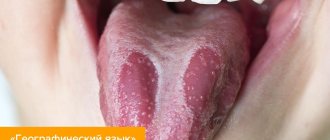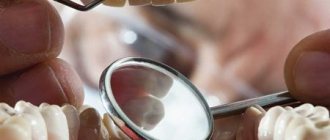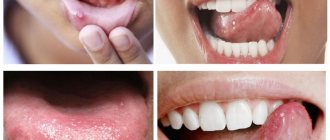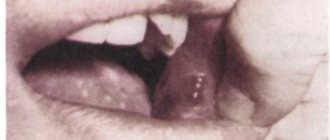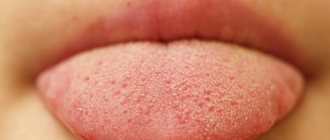The tongue is needed to recognize the taste of food, but, in addition, it is a kind of indicator of human health. Any changes on its surface signal problems in the body . For example, red spots on the tongue of an adult or child may appear due to the development of stomatitis, scarlet fever, diseases of the gallbladder, intestines, problems with the heart, liver or kidneys.
Causes
The exact causes of the pathology are not fully understood. The disease is not an independent disease; it appears against the background of other diseases. Most often, this phenomenon occurs in men over 40 years of age, but is sometimes observed in women. This disease is very rare in children.
The pathology is most often observed in people with gastrointestinal dysfunction, ulcers and gastritis. The development of the disease is greatly facilitated by poor oral hygiene, smoking habits and excessive coffee consumption.
The main causes of the development of the disease are considered:
- long-term use of medications, especially antibiotics;
- fungal infections;
- dehydration;
- chemotherapy;
- metabolic disease;
- weakened immune system;
- Regular rinsing of the mouth with solutions containing astringents.
The risk group also includes people with dental defects and the absence of a large number of teeth, since in this case they are forced to eat only soft food, which does not have the proper abrasive effect on the surface of the tongue.
What changes can there be in the language?
Every morning and evening, after brushing your teeth, it is necessary to examine the oral cavity for pathological changes. The procedure, which only takes one or two minutes, helps to avoid serious illnesses. If a red spot appears on the tongue, it may indicate the development of an allergic reaction, internal or local infectious pathology. With such a symptom you should consult a doctor.
The tongue of a healthy person should be uniformly pink in color, without changes in relief, moist, clean, not enlarged, painless, and moderately sensitive. Pathological changes can be very diverse - from simple redness to ulceration. Here are the main ones:
- neoplasms;
- itching;
- plaque;
- color change;
- ulcers;
- dashes;
- spots of various colors;
- wounds;
- plaques.
It must be remembered that many changes in the language appear for serious reasons and may not be very noticeable at first. Some, such as plaque or discoloration, may not cause discomfort to a person, but this is not a reason to let the situation take its course. The most common problem is stains.
Symptoms
Pathology is immediately detected during a visual examination by a dentist. In the initial stages of the disease, the presence of a foreign object in the mouth is felt, other unpleasant signs gradually appear, then the upper part of the tongue noticeably turns black. In advanced cases, the affected area occupies two-thirds of the tongue. The disease is accompanied by unpleasant odor from the mouth, changes in taste sensations, a metallic taste appears in the mouth, a feeling of tickling and soreness on the surface of the tongue, as well as causeless nausea. In rare cases, there is a burning sensation and severe itching.
Which doctor should you contact?
Few people know which specialist to contact if their tongue becomes stained. In fact, a whole group of doctors can help establish the cause of the disease and get rid of it: a dermatovenerologist, an ENT doctor, a surgeon, a dentist, a pulmonologist, a gastroenterologist and others. The first thing the patient should do is visit a therapist or dentist, who, if necessary, will refer him to a more specialized specialist.
Any pathology, be it small red dots or redness of the entire surface of the tongue, requires timely consultation with a competent doctor.
Treatment
It is necessary to contact a dentist or maxillofacial surgeon with such a problem. To obtain a complete clinical picture, it is necessary to undergo examination by a gastroenterologist, infectious disease specialist, endocrinologist and neurologist. Since the pathology develops against the background of other diseases, a comprehensive treatment regimen is used.
Only treatment of concomitant diseases, professional cleaning and treatment of the oral cavity, taking multivitamin complexes, antifungal medications and, if necessary, sedatives will help eliminate this unpleasant defect. Removal of heavily overgrown papillae can be carried out by cryodestruction (exposure to the pathological focus with liquid nitrogen). It is also necessary to adjust your diet, enriching it with foods with fiber, vitamins and minerals.
The prognosis for black hairy tongue is usually favorable. Elimination of causative factors, as well as appropriate comprehensive treatment of the disease, leads to complete restoration of the surface of the tongue.
Types of spots on the tongue and the reasons for their appearance
The spots can be of different colors: red, white, yellow, pink, brown and even black. The location of the spots also varies widely: at the tip, at the root, under the tongue or on the sides. Even the relief of the formations may differ from the relief of healthy tissues, which is associated with atrophy of the taste buds.
Photo: white spot on the tongue of an adult
There may be several spots or just one. They come in big and small, round and dotted. It is important to remember that any spots on the tongue indicate problems in the body. All of them are a deviation from the norm and necessarily require a doctor’s diagnosis.
Why do red spots appear on the tongue?
The tongue may become covered with red spots for the following reasons:
- A red spot or blister that does not go away for a long time may indicate such a terrible disease as cancer. Therefore, if it is detected, you should immediately seek medical help.
Scarlet feverAnother reason for the appearance of red spots on the tongue is scarlet fever. Children are most often affected by this disease. In the early stages of the disease, the spots are surrounded by bubbles; when they burst, small ulcers form in their place.
- Another terrible disease in which red spots form on the mucous membrane of the tongue is AIDS. Such spots are localized at the tip or at the root of the organ; they usually protrude above the general surface, reach 7–8 mm in width and are covered with a pale gray coating. Lymph nodes with this disease are always enlarged.
StomatitisStomatitis is far from the least important cause of the appearance of red spots. Most often, dental red spots are located on the root of the tongue, sometimes they are only surrounded by a red halo, but inside are covered with a white coating.
- If red dots and a white coating appear on the tongue, this is the so-called geographic tongue. This disease often occurs in children and pregnant women.
- Hemorrhages can also cause spotting. However, they are usually accompanied by the appearance of red dots on the tip of the tongue, and not full-fledged spots. Hemorrhage may indicate a disease such as mononucleosis.
- The mucous membrane of the taste organ may become colored after eating food with dyes.
- Allergic reaction.
- Mechanical or chemical damage (burns, wounds).
Brown spots on the tongue
There are few reasons why brown spots may appear on the tongue:
Smoking. This bad habit contributes to the formation of an unaesthetic brown dark plaque on the mucous membranes of the mouth and teeth.- Eating food with dyes, chocolate, large amounts of tea or coffee gives a spotty effect.
- The light brown color of the spot indicates problems with joints or diseases of the upper respiratory tract.
- Brown spots with a yellow tint indicate dependence on alcohol, diseases of the lungs and bronchi, as well as drug intoxication.
A dark spot on the tongue is an alarming sign. In this way, the body reflects problems with the gastrointestinal tract, “talks” about kidney and liver diseases, and problems with the gallbladder. If a dark spot is detected, you need to undergo a comprehensive examination in the clinic, identify the cause of the disease and eliminate it.
Red spots and dots on the tongue with a white coating
In both adults and children, red spots on the tongue can appear in tandem with a white coating. Red spots with plaque appear on the tongue against the background of such pathologies:
- Constipation. Prolonged constipation causes intestinal problems, which in turn affects the entire body and can lead to red circles on the tongue.
- Poisoning. This disease can cause small red dots and plaque to appear on the tongue.
- Lack of vitamins and nutrients. With vitamin deficiency, the color of the surface of the tongue often changes to pale with small specks. Weakness, lethargy, and pallor of the skin are added to spotting.
- Kidney dysfunction. Round pink spots form on the tongue.
- Inflammation. Redness of the taste organ may be accompanied by burning, pain, irritation and increased sensitivity to hot and cold.
The tongue becomes covered with a white coating due to many diseases. Even a common cold, poor diet, or the wrong medication can lead to the formation of plaque in the mouth.
Causes of a “bald” tongue
“Bald” spots on the tongue indicate atrophy of the taste buds. With this pathology, some areas of the tongue become completely smooth, as if polished, and acquire a pinkish or bright red color.
Causes of pathology:
- Burns that quickly pass, and the “bald spot” is again overgrown with papillae. A burn is always accompanied by a burning sensation.
- Lack of vitamins and nutrients: B1, B2, B12, PP, proteins.
- Chronic malnutrition.
- Anemia.
- Smoking.
- Infections.
- Excessive alcohol consumption.
- Dehydration.
Redness of the entire surface of the tongue and its “baldness” are often caused by chemotherapy. Smooth pink spots appear with psoriasis.
Other pathologies
Black, blue, green, yellow spots and plaques on the tongue are not as common as those listed above. What do they mean:
- Black spots occur due to fungal infection or iron oxidation - in the presence of piercings.
Photo of plaques on the tongue with leukoplakiaYellow is a common symptom of jaundice. With this disease, the skin of the body also acquires a yellow tint.
- Green - can be either a symptom of candidiasis (fungal infection) or a consequence of smoking, damage to the mucous membrane or oxidation of the piercing.
- Blue ones are often harbingers of more serious pathologies, such as cancer or pneumonia. The tongue is blue in case of sepsis, bronchial asthma, all kinds of heart defects or poisoning. Most often, the reason for the appearance of blue spots on the tongue is problems in the functioning of the human respiratory system.
- Formations in the form of plaques appear on the mucous membranes of leukoplakia due to too rapid growth of benign cells.
Prevention
As such, there is no prevention of black villous tongue. Even with good oral hygiene, you can encounter a similar phenomenon, but with timely treatment of diseases that lead to the development of such a complication, you can minimize the likelihood of the disease occurring.
The following rules must also be observed:
- thoroughly brush your teeth, gums and tongue with a soft brush;
- It is necessary to drink enough water, because if there is a lack of hydration in the oral cavity, it begins to develop; bacteria;
- reduce coffee consumption and quit smoking and alcoholic beverages.
The disease recurs quite rarely. During an exacerbation, the patient is advised to follow a gentle diet; food should be warm and soft in consistency.


